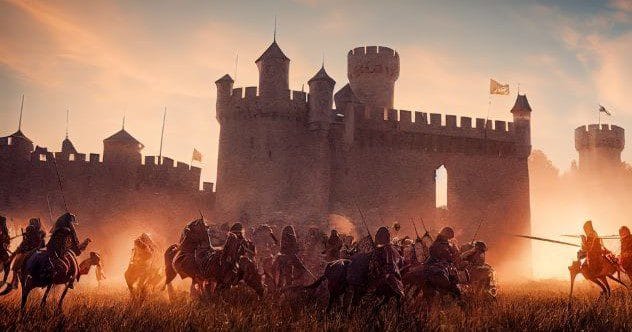Throughout history, fortresses have represented the pinnacle of defensive architecture. From simple wooden structures to complex networks of walls and traps, these strongholds were designed to withstand the most determined invaders. Let’s explore ten fortresses that proved to be a nightmare for anyone trying to conquer them.
Masada
Defenses: Masada’s almost impregnable nature came from its location atop an isolated plateau, towering 1,424 feet (434 meters) above the desert. The Hasmoneans fortified it in the 2nd century BC, and Herod the Great later enhanced it as his palace. Herod constructed a 4,500-foot-long (1,372-meter) double wall around the mesa’s perimeter, fortified by over 30 towers and four gates. Aqueducts supplied 200,000 gallons (757,082 liters) of water to cisterns, and storerooms were filled with enough food to sustain 10,000 defenders for months.
Was It Conquered?: Jewish rebels used Masada as a stronghold after the fall of Jerusalem. In AD 72, the Roman Xth Legion besieged Masada with nearly 15,000 soldiers against about a thousand Jews. The Romans built a ramp to breach the wall. The defenders committed mass suicide rather than be enslaved.
The Theodosian Walls
Defenses: Emperor Theodosius II built Constantinople’s defensive walls, which were improved over centuries. The first obstacle was a 65-foot (20-meter) wide and 23-foot (7-meter) deep ditch that could be flooded. Behind this was an outer wall, followed by a second wall with towers. The main wall was 16 feet (5 meters) thick and 39 feet (12 meters) high, with 96 towers capable of holding artillery. Built on rising ground, this design prevented siege engines from reaching the inner wall. Defenders used Greek fire against attackers.
Was It Conquered?: For 800 years, the walls withstood Persians, Slavs, Avars, and Bulgars. The Fourth Crusade captured Constantinople in 1204 due to an open gate. The city was restored to the Byzantines, but the empire declined. In 1453, Ottoman Sultan Mehmed II attacked with 50,000 to 80,000 troops against only 7,000 defenders. Mehmed’s massive cannons eventually breached the walls after 53 days of relentless assault.
Kenilworth Castle
Defenses: Started in the late 11th century, Kenilworth Castle in Warwickshire features water defenses and walls-within-walls. Originally a motte and bailey structure, it evolved into a stone castle strengthened by King John. The Great Keep had “fishtail” slits for crossbows. Nearby brooks were dammed to create the Great Mere, an artificial lake that protected all but the north side, making the castle nearly impregnable.
Was It Conquered?: During the barons’ revolt against King Henry III, royal forces besieged Kenilworth for six months in 1266. Prince Edward attempted to breach the defenses with trebuchets, but the Great Mere stymied even a nighttime waterborne assault. Eventually, disease forced the castle’s surrender, not military might.
Mont St. Michel
Defenses: Mont St. Michel, built on a tidal island off the Normandy coast, is naturally defended by strong tides with a 50-foot (15-meter) difference between high and low. The tides can create quicksand conditions. French kings Philip II and Louis IX further fortified the island with defensive walls.
Was It Conquered?: Mont St. Michel’s defenses were continuously upgraded during the Hundred Years’ War. Despite a siege in 1421 that collapsed the church chancel, the citadel, defended by a small number of knights, withstood English attacks for over 30 years.
Krak des Chevaliers
Defenses: Located near the Syria-Lebanon border, Krak des Chevaliers incorporated advanced 13th-century castle engineering. It featured massive towers, thicker double walls with sloped bases, machicolations, loopholes, and “murder holes.” The Crusaders smoothed the rock summit to deny attackers any grip. The main gateway was reached via a hairpin bend, and changes in lighting levels disoriented attackers.
Was It Conquered?: In 1271, Muslim Mamluk leader Al-Zahir Baybars besieged the Krak. His catapults destroyed an outer tower, and breaching the inner wall took two weeks. The surviving Hospitallers held the largest tower for ten more days until a forged letter instructed them to surrender.
Kumbhalgarh
Defenses: In Rajasthan, India, Kumbhalgarh is surrounded by mountains 3,560 feet (1,087 meters) high. Its walls stretch 20 miles (32 kilometers), with widths from 15 to 25 feet (4.5 to 7.6 meters). Access is through sharply turning ramps and seven gates with iron doors studded with spikes. Narrow passages and traps further complicated entry.
Was It Conquered?: Built in the 15th century, Kumbhalgarh remained invincible until 1576, when Emperor Akbar’s general, Shahbaz Khan, poisoned the water supply, forcing the defenders to surrender.
Hochosterwitz
Defenses: Perched atop a 564-foot (172-meter) dolomite rock in Carinthia, Austria, Hochosterwitz Castle is accessed via a winding path blocked by 14 fortified gates. Attackers had to capture each gate while facing ambushes. The castle also featured a square tower and walls.
Was It Conquered?: The gates were built between 1571 and 1600 during Turkish incursions. The Ottomans tried to take the castle but never breached the fourth gate. Hochosterwitz remains in the same family’s possession to this day.
Castillo de San Marcos
Defenses: Built by the Spanish in St. Augustine, Florida, between 1672 and 1695, San Marcos is the oldest seacoast fort in the U.S. Its star-shaped bastion design minimized the impact of cannon fire, giving defenders a greater firing range. The walls were built from coquina, a local limestone with microscopic air pockets.
Was It Conquered?: British forces besieged St. Augustine in 1702 and 1740, but their shells were either deflected or harmlessly absorbed by the coquina walls. San Marcos was never taken by force and was ceded by treaty after the Seven Years’ War.
Murud Janjira
Defenses: An oblong fort on an island in the Arabian Sea, Janjira could only be approached by sea. It featured 40-foot (12-meter) high walls with 19 bastions and over 500 cannons, including three of India’s largest. The Kalal Bangadi cannon weighed 22 tons and could fire a projectile up to 7 miles (12 kilometers).
Was It Conquered?: Maratha ruler Chatrapathi Shivaji tried to take the fort thirteen times between 1659 and 1678 but failed. His son Sambhaji attempted to build a causeway but had to retreat due to an attack on his fort. Janjira was never conquered, resisting the Portuguese, Dutch, and British.
Switzerland
Defenses: The entire country is a fortress, protected by the Alpine mountains. The Swiss National Redoubt is a network of bunkers, tunnels, and shelters hidden within the mountains. During the Cold War, roads, bridges, and railroads were rigged with explosives. Mountainsides were booby-trapped to cause rockslides, and the population had access to bomb shelters. All able-bodied men receive military training and were instructed to flee to the mountains and fight individually if invaded during WWII.
Was It Conquered?: The Nazis planned to invade Switzerland during World War II with Operation Tannenbaum, but they realized the costs were too high. Switzerland remains unconquered to this day.
These ten fortresses showcase the ingenuity and determination of defenders throughout history. Their designs, locations, and the stories of those who defended them continue to fascinate and inspire. From natural barriers to innovative engineering, these strongholds were truly nightmares for those who dared to attack.
Which of these fortresses do you find the most impressive? Leave your comment below!










